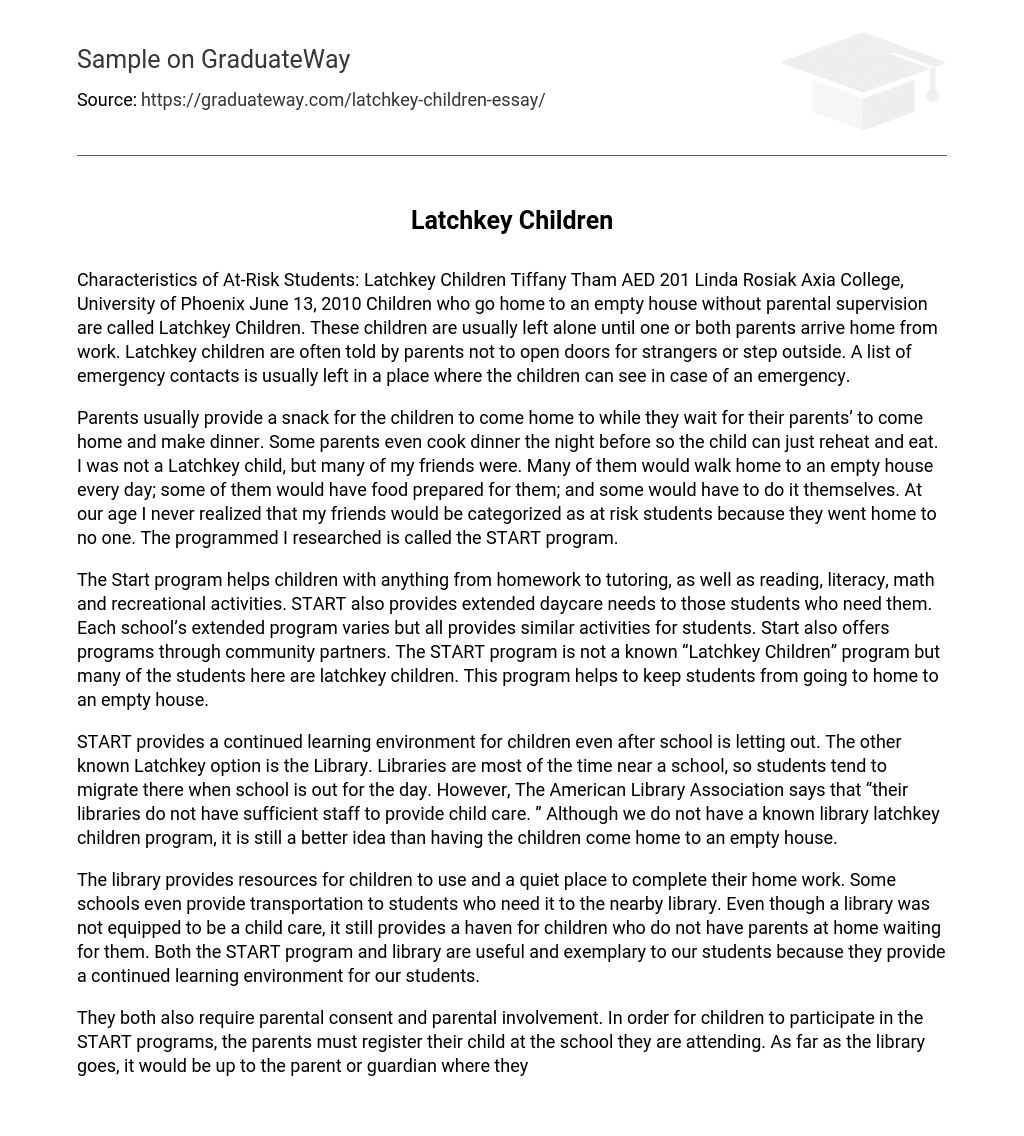Latchkey Children are children who are left unsupervised at home without parental supervision. They are typically alone until one or both parents return from work. Parents give instructions to these children, such as not opening doors for strangers or leaving the house. They also usually provide a list of emergency contacts in a visible location for any emergencies.
Parents typically provide their children with a snack to eat prior to dinner while they wait for their parents. In some cases, parents even prepare dinner in advance so that the child can simply reheat and consume it. Although I personally did not experience being a Latchkey child, many of my friends did. Upon returning home, they would often find an empty house, with some having food readily available while others had to prepare it themselves. At that time, I failed to comprehend that my friends were categorized as at-risk students due to lacking someone at home. The program I have studied is referred to as the START program.
The Start program provides support to children in multiple areas including homework, tutoring, reading, literacy, math, and recreational activities. Additionally, it offers extended daycare services for students needing them. While each school’s extended program may vary, they all offer similar activities. Start partners with the community to provide extra programs. Although not specifically labeled as a “Latchkey Children” program, many of the students involved are latchkey children. The main goal of the program is to keep students from coming back to an empty house after school.
START offers a continued learning environment for children after school ends, while the Library is also a known Latchkey option. Since libraries are usually located near schools, students often head there once school is over. However, The American Library Association states that their libraries lack the necessary staff to provide childcare. Despite not having a library latchkey program, it is still a preferable choice compared to leaving children home alone.
The library provides resources for children and a peaceful area where they can complete their homework. In addition, some schools arrange transportation to the library for students requiring it. Although the library is not intended as a childcare facility, it still acts as a sanctuary for children lacking parental supervision at home. Both the START program and the library are highly beneficial and commendable for our students since they offer an enduring educational setting.
Both the START programs and library services necessitate parental consent and involvement. Parents must enroll their child at the school they attend to enable their participation in the START programs. Regarding the library, the decision on where children go after school depends on the parent or guardian. The START program aligns with the school schedule, meaning it will be accessible as long as school is in session. While the START program offers post-school year activities, this varies according to district.
The library follows the school calendar, but it stays open during school breaks to offer students a learning environment. These libraries have additional activities for students who visit frequently during breaks, which are designed to engage parents and reach all targeted students. The library is a free resource that provides a safe and educational space for children. Offering transportation is also convenient for parents concerned about how their children will get there.
The parent only needs to pick up the child before the library closes. The START program is a free program provided through the district to offer tutoring and activities for children. It educates and provides various activities for students on campus while parents are at work. START also offers over 3,000 recreational activities to keep children active and learning. Both programs benefit parents and children by ensuring their safety and providing a safe environment for children to be active.
References
- American Library Association (ALA). ALA YEARBOOK. Chicago: American Library Association, 1989.
- Dowd, F. S. (2003-2007). ERICDigets. org. Retrieved from http://www. ericdigests. org/1992-4/latchkey. htm
- City of Sacramento. (2010). City of Sacramento Department of Parks and Recreation. Retrieved from http://www. sacstart. org/about. htm
- Kauchak, D. , & Eggen, P. Introduction to Teaching: Becoming a Professional (2nd Ed. ). : Prentice-Hall/Merrill.





